Assertion :− Walking on horizontal slippery ice can be much more tiring than walking on ordinary pavement.
Reason :− walking on ice requires small steps to prevent slipping.
If both Assertion & Reason are True & the Reason is a correct explanation of the Assertion.
If both Assertion & Reason are True but Reason is not a correct explanation of the Assertiion.
If Assertion is True but the Reason is False.
If both Assertion & Reason are False
The correct Answer is:A
To analyze the assertion and reason provided in the question, we can break it down into a step-by-step solution.
1. Understanding the Assertion:
- The assertion states that walking on horizontal slippery ice can be much more tiring than walking on ordinary pavement.
- This is due to the nature of the surface; ice is slippery, which makes it harder to maintain balance.
Hint: Consider how friction affects walking on different surfaces.
2. Understanding the Reason:
- The reason given is that walking on ice requires small steps to prevent slipping.
- When walking on slippery surfaces, taking small steps helps maintain balance and reduces the risk of falling.
Hint: Think about how the size of steps influences stability on slippery surfaces.
3. Connecting Assertion and Reason:
- The reason explains why the assertion is true. Walking on ice requires more effort to maintain stability, which can lead to increased fatigue.
- The need to take small steps means that the walker has to exert more energy to keep their balance, making the activity more tiring.
Hint: Reflect on how maintaining balance affects energy expenditure during walking.
4. Conclusion:
- Both the assertion and the reason are correct. The reason provides a valid explanation for the assertion. Walking on ice is indeed more tiring due to the need for small steps to prevent slipping.
Hint: Consider how explanations help clarify the relationship between two statements.
Final Answer:
Both the assertion and the reason are correct, and the reason correctly explains the assertion. Walking on slippery ice is more tiring due to the need for small steps for stability.
- The assertion states that walking on horizontal slippery ice can be much more tiring than walking on ordinary pavement.
- This is due to the nature of the surface; ice is slippery, which makes it harder to maintain balance.
- The reason given is that walking on ice requires small steps to prevent slipping.
- When walking on slippery surfaces, taking small steps helps maintain balance and reduces the risk of falling.
- The reason explains why the assertion is true. Walking on ice requires more effort to maintain stability, which can lead to increased fatigue.
- The need to take small steps means that the walker has to exert more energy to keep their balance, making the activity more tiring.
- Both the assertion and the reason are correct. The reason provides a valid explanation for the assertion. Walking on ice is indeed more tiring due to the need for small steps to prevent slipping.
Both the assertion and the reason are correct, and the reason correctly explains the assertion. Walking on slippery ice is more tiring due to the need for small steps for stability.
Topper's Solved these Questions
- TEST PAPERBOOK - ALLENCHAPTER - TEST PAPEREXERCISE - Exercise (Physics)
330 Videos
- TEST PAPERBOOK - ALLENCHAPTER - TEST PAPEREXERCISE - PHYSICS
4 Videos
- SIMPLE HARMONIC MOTIONBOOK - ALLENCHAPTER - SIMPLE HARMONIC MOTIONEXERCISE - Example
1 Videos
- TEST PAPER 1BOOK - ALLENCHAPTER - TEST PAPER 1EXERCISE - PHYSICS
11 Videos
Similar Questions
Knowledge Check
Dark Snow
Most of Greenland’s interior is covered by a thick layer of ice and compressed snow known as the Greenland Ice Sheet. The size of the ice sheet fluctuates seasonally: in summer, average daily high temperatures in Greenland can rise to slightly above 50 degrees Fahrenheit, partially melting the ice, in the winter, the sheet thickens as additional snow falls, and average daily low temperatures can drop to (12) as low as 20 degrees–––––––––––––––––––––.

Typically, the ice sheet begins to show evidence of thawing in late (13)summer. This follows––––––––––––––––––––––– several weeks of higher temperatures. 14 For example––––––––––––––, in the summer of 2012, virtually the entire Greenland Ice Sheet underwent thawing at or near its surface by mid-July, the earliest date on record. Most scientists looking for the causes of the Great Melt of 2012 have focused exclusively on rising temperatures. The summer of 2012 was the warmest in 170 years, records show. But Jason (15) Box, an associate––––––––––––––––––– professor of geology at Ohio State believes that another factor added to the early (16) (thaw), the “dark snow” problem.
According to Box, a leading Greenland expert, tundra fires in 2012 from as far away as North America produced great amounts of soot, some (17) of it–––––drifted over Greenland in giant plumes of smoke and then (18) fell–––– as particles onto the ice sheet. Scientists have long known that soot particles facilitate melting by darkening snow and ice, limiting (19) it’s–––– ability to reflect the Sun’s rays. As Box explains, “Soot is an extremely powerful light absorber. It settles over the ice and captures the Sun’s heat.” The result is a self-reinforcing cycle. As the ice melts, the land and water under the ice become exposed, and since land and water are darker than snow, the surface absorbs even more heat, which (20) is related to the rising temperatures–––––––––––––––––––––––––––––––––––––––.
[1] Box’s research is important because the fires of 2012 may not be a one-time phenomenon. [2] According to scientists, rising Arctic temperatures are making northern latitudes greener and thus more fire prone.[3] The pattern Box observed in 2012 may repeat (21) itself again––––––––––––, with harmful effects on the Arctic ecosystem. [4] Box is currently organizing an expedition to gather this crucial information. [5] The next step for Box and his team is to travel to Greenland to perform direct sampling of the ice in order to determine just how much the soot is contributing to the melting of the ice sheet. [6] Members of the public will be able to track his team’s progress—and even help fund the expedition—through a website Box has created. (22)ANO CHANGEBHowever,CAs such,DMoreover,Dark Snow
Most of Greenland’s interior is covered by a thick layer of ice and compressed snow known as the Greenland Ice Sheet. The size of the ice sheet fluctuates seasonally: in summer, average daily high temperatures in Greenland can rise to slightly above 50 degrees Fahrenheit, partially melting the ice, in the winter, the sheet thickens as additional snow falls, and average daily low temperatures can drop to (12) as low as 20 degrees–––––––––––––––––––––.
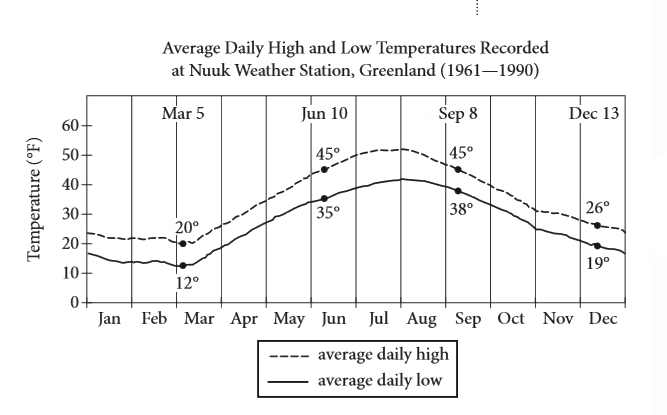
Typically, the ice sheet begins to show evidence of thawing in late (13)summer. This follows––––––––––––––––––––––– several weeks of higher temperatures. 14 For example––––––––––––––, in the summer of 2012, virtually the entire Greenland Ice Sheet underwent thawing at or near its surface by mid-July, the earliest date on record. Most scientists looking for the causes of the Great Melt of 2012 have focused exclusively on rising temperatures. The summer of 2012 was the warmest in 170 years, records show. But Jason (15) Box, an associate––––––––––––––––––– professor of geology at Ohio State believes that another factor added to the early (16) (thaw), the “dark snow” problem.
According to Box, a leading Greenland expert, tundra fires in 2012 from as far away as North America produced great amounts of soot, some (17) of it–––––drifted over Greenland in giant plumes of smoke and then (18) fell–––– as particles onto the ice sheet. Scientists have long known that soot particles facilitate melting by darkening snow and ice, limiting (19) it’s–––– ability to reflect the Sun’s rays. As Box explains, “Soot is an extremely powerful light absorber. It settles over the ice and captures the Sun’s heat.” The result is a self-reinforcing cycle. As the ice melts, the land and water under the ice become exposed, and since land and water are darker than snow, the surface absorbs even more heat, which (20) is related to the rising temperatures–––––––––––––––––––––––––––––––––––––––.
[1] Box’s research is important because the fires of 2012 may not be a one-time phenomenon. [2] According to scientists, rising Arctic temperatures are making northern latitudes greener and thus more fire prone.[3] The pattern Box observed in 2012 may repeat (21) itself again––––––––––––, with harmful effects on the Arctic ecosystem. [4] Box is currently organizing an expedition to gather this crucial information. [5] The next step for Box and his team is to travel to Greenland to perform direct sampling of the ice in order to determine just how much the soot is contributing to the melting of the ice sheet. [6] Members of the public will be able to track his team’s progress—and even help fund the expedition—through a website Box has created. (22)ANO CHANGEBitselfCitself, with damage andDitself possiblyDark Snow
Most of Greenland’s interior is covered by a thick layer of ice and compressed snow known as the Greenland Ice Sheet. The size of the ice sheet fluctuates seasonally: in summer, average daily high temperatures in Greenland can rise to slightly above 50 degrees Fahrenheit, partially melting the ice, in the winter, the sheet thickens as additional snow falls, and average daily low temperatures can drop to (12) as low as 20 degrees–––––––––––––––––––––.
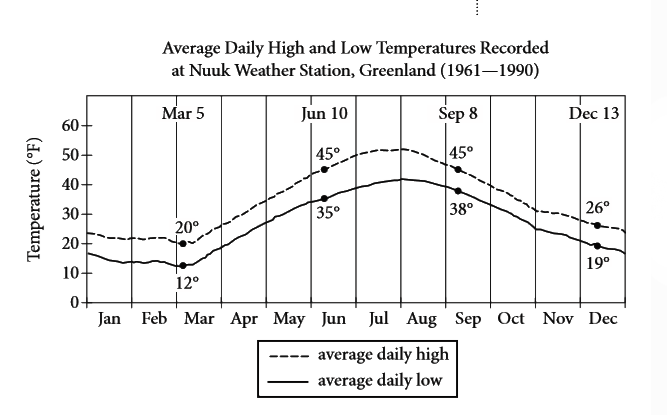
Typically, the ice sheet begins to show evidence of thawing in late (13)summer. This follows––––––––––––––––––––––– several weeks of higher temperatures. 14 For example––––––––––––––, in the summer of 2012, virtually the entire Greenland Ice Sheet underwent thawing at or near its surface by mid-July, the earliest date on record. Most scientists looking for the causes of the Great Melt of 2012 have focused exclusively on rising temperatures. The summer of 2012 was the warmest in 170 years, records show. But Jason (15) Box, an associate––––––––––––––––––– professor of geology at Ohio State believes that another factor added to the early (16) (thaw), the “dark snow” problem.
According to Box, a leading Greenland expert, tundra fires in 2012 from as far away as North America produced great amounts of soot, some (17) of it–––––drifted over Greenland in giant plumes of smoke and then (18) fell–––– as particles onto the ice sheet. Scientists have long known that soot particles facilitate melting by darkening snow and ice, limiting (19) it’s–––– ability to reflect the Sun’s rays. As Box explains, “Soot is an extremely powerful light absorber. It settles over the ice and captures the Sun’s heat.” The result is a self-reinforcing cycle. As the ice melts, the land and water under the ice become exposed, and since land and water are darker than snow, the surface absorbs even more heat, which (20) is related to the rising temperatures–––––––––––––––––––––––––––––––––––––––.
[1] Box’s research is important because the fires of 2012 may not be a one-time phenomenon. [2] According to scientists, rising Arctic temperatures are making northern latitudes greener and thus more fire prone.[3] The pattern Box observed in 2012 may repeat (21) itself again––––––––––––, with harmful effects on the Arctic ecosystem. [4] Box is currently organizing an expedition to gather this crucial information. [5] The next step for Box and his team is to travel to Greenland to perform direct sampling of the ice in order to determine just how much the soot is contributing to the melting of the ice sheet. [6] Members of the public will be able to track his team’s progress—and even help fund the expedition—through a website Box has created. (22)
22. To make this paragraph most logical, sentence 4 should be placedAwhere it is now.Bafter sentence 1Cafter sentence 2Dafter sentence 3
Assertion : Sometimes insects can walk on water.
Reason : The gravitational force on insect is balanced by force due surface tension.
View SolutionAssertion : In optical fibre, the diameter of the core is kept small.
Reason : This smaller diameter of the core ensures that the fibre should have incident angle more than the critical angle required for total internal reflection.
View SolutionDark Snow
Most of Greenland’s interior is covered by a thick layer of ice and compressed snow known as the Greenland Ice Sheet. The size of the ice sheet fluctuates seasonally: in summer, average daily high temperatures in Greenland can rise to slightly above 50 degrees Fahrenheit, partially melting the ice, in the winter, the sheet thickens as additional snow falls, and average daily low temperatures can drop to (12) as low as 20 degrees–––––––––––––––––––––.
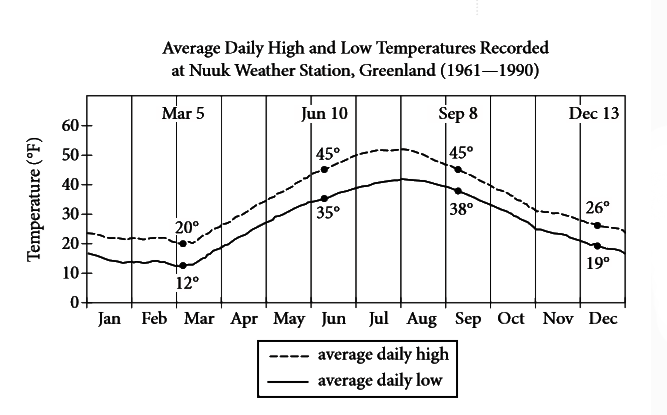
Typically, the ice sheet begins to show evidence of thawing in late (13)summer. This follows––––––––––––––––––––––– several weeks of higher temperatures. 14 For example––––––––––––––, in the summer of 2012, virtually the entire Greenland Ice Sheet underwent thawing at or near its surface by mid-July, the earliest date on record. Most scientists looking for the causes of the Great Melt of 2012 have focused exclusively on rising temperatures. The summer of 2012 was the warmest in 170 years, records show. But Jason (15) Box, an associate––––––––––––––––––– professor of geology at Ohio State believes that another factor added to the early (16) (thaw), the “dark snow” problem.
According to Box, a leading Greenland expert, tundra fires in 2012 from as far away as North America produced great amounts of soot, some (17) of it–––––drifted over Greenland in giant plumes of smoke and then (18) fell–––– as particles onto the ice sheet. Scientists have long known that soot particles facilitate melting by darkening snow and ice, limiting (19) it’s–––– ability to reflect the Sun’s rays. As Box explains, “Soot is an extremely powerful light absorber. It settles over the ice and captures the Sun’s heat.” The result is a self-reinforcing cycle. As the ice melts, the land and water under the ice become exposed, and since land and water are darker than snow, the surface absorbs even more heat, which (20) is related to the rising temperatures–––––––––––––––––––––––––––––––––––––––.
[1] Box’s research is important because the fires of 2012 may not be a one-time phenomenon. [2] According to scientists, rising Arctic temperatures are making northern latitudes greener and thus more fire prone.[3] The pattern Box observed in 2012 may repeat (21) itself again––––––––––––, with harmful effects on the Arctic ecosystem. [4] Box is currently organizing an expedition to gather this crucial information. [5] The next step for Box and his team is to travel to Greenland to perform direct sampling of the ice in order to determine just how much the soot is contributing to the melting of the ice sheet. [6] Members of the public will be able to track his team’s progress—and even help fund the expedition—through a website Box has created. (22)
13. Which choice most effectively combines the two sentences at the underlined portion?
View SolutionDark Snow
Most of Greenland’s interior is covered by a thick layer of ice and compressed snow known as the Greenland Ice Sheet. The size of the ice sheet fluctuates seasonally: in summer, average daily high temperatures in Greenland can rise to slightly above 50 degrees Fahrenheit, partially melting the ice, in the winter, the sheet thickens as additional snow falls, and average daily low temperatures can drop to (12) as low as 20 degrees–––––––––––––––––––––.
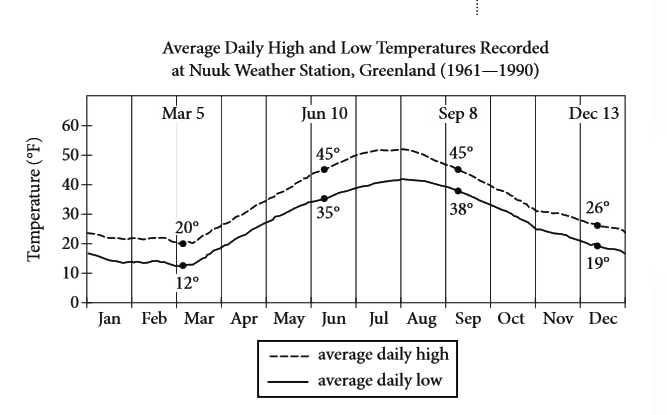
Typically, the ice sheet begins to show evidence of thawing in late (13)summer. This follows––––––––––––––––––––––– several weeks of higher temperatures. 14 For example––––––––––––––, in the summer of 2012, virtually the entire Greenland Ice Sheet underwent thawing at or near its surface by mid-July, the earliest date on record. Most scientists looking for the causes of the Great Melt of 2012 have focused exclusively on rising temperatures. The summer of 2012 was the warmest in 170 years, records show. But Jason (15) Box, an associate––––––––––––––––––– professor of geology at Ohio State believes that another factor added to the early (16) (thaw), the “dark snow” problem.
According to Box, a leading Greenland expert, tundra fires in 2012 from as far away as North America produced great amounts of soot, some (17) of it–––––drifted over Greenland in giant plumes of smoke and then (18) fell–––– as particles onto the ice sheet. Scientists have long known that soot particles facilitate melting by darkening snow and ice, limiting (19) it’s–––– ability to reflect the Sun’s rays. As Box explains, “Soot is an extremely powerful light absorber. It settles over the ice and captures the Sun’s heat.” The result is a self-reinforcing cycle. As the ice melts, the land and water under the ice become exposed, and since land and water are darker than snow, the surface absorbs even more heat, which (20) is related to the rising temperatures–––––––––––––––––––––––––––––––––––––––.
[1] Box’s research is important because the fires of 2012 may not be a one-time phenomenon. [2] According to scientists, rising Arctic temperatures are making northern latitudes greener and thus more fire prone.[3] The pattern Box observed in 2012 may repeat (21) itself again––––––––––––, with harmful effects on the Arctic ecosystem. [4] Box is currently organizing an expedition to gather this crucial information. [5] The next step for Box and his team is to travel to Greenland to perform direct sampling of the ice in order to determine just how much the soot is contributing to the melting of the ice sheet. [6] Members of the public will be able to track his team’s progress—and even help fund the expedition—through a website Box has created. (22)
12. Which choice most accurately and effectively represents the information in the graph?
View SolutionDark Snow
Most of Greenland’s interior is covered by a thick layer of ice and compressed snow known as the Greenland Ice Sheet. The size of the ice sheet fluctuates seasonally: in summer, average daily high temperatures in Greenland can rise to slightly above 50 degrees Fahrenheit, partially melting the ice, in the winter, the sheet thickens as additional snow falls, and average daily low temperatures can drop to (12) as low as 20 degrees–––––––––––––––––––––.
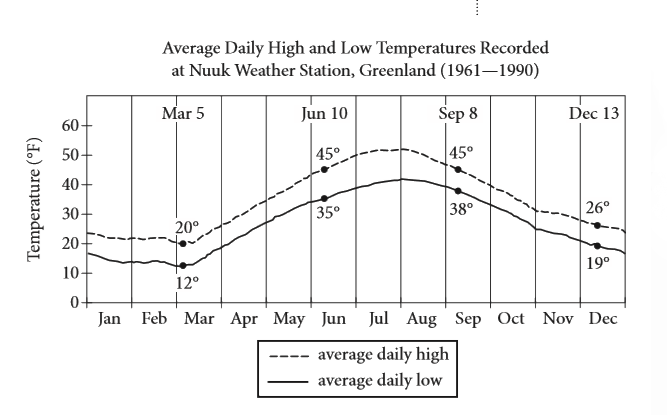
Typically, the ice sheet begins to show evidence of thawing in late (13)summer. This follows––––––––––––––––––––––– several weeks of higher temperatures. 14 For example––––––––––––––, in the summer of 2012, virtually the entire Greenland Ice Sheet underwent thawing at or near its surface by mid-July, the earliest date on record. Most scientists looking for the causes of the Great Melt of 2012 have focused exclusively on rising temperatures. The summer of 2012 was the warmest in 170 years, records show. But Jason (15) Box, an associate––––––––––––––––––– professor of geology at Ohio State believes that another factor added to the early (16) (thaw), the “dark snow” problem.
According to Box, a leading Greenland expert, tundra fires in 2012 from as far away as North America produced great amounts of soot, some (17) of it–––––drifted over Greenland in giant plumes of smoke and then (18) fell–––– as particles onto the ice sheet. Scientists have long known that soot particles facilitate melting by darkening snow and ice, limiting (19) it’s–––– ability to reflect the Sun’s rays. As Box explains, “Soot is an extremely powerful light absorber. It settles over the ice and captures the Sun’s heat.” The result is a self-reinforcing cycle. As the ice melts, the land and water under the ice become exposed, and since land and water are darker than snow, the surface absorbs even more heat, which (20) is related to the rising temperatures–––––––––––––––––––––––––––––––––––––––.
[1] Box’s research is important because the fires of 2012 may not be a one-time phenomenon. [2] According to scientists, rising Arctic temperatures are making northern latitudes greener and thus more fire prone.[3] The pattern Box observed in 2012 may repeat (21) itself again––––––––––––, with harmful effects on the Arctic ecosystem. [4] Box is currently organizing an expedition to gather this crucial information. [5] The next step for Box and his team is to travel to Greenland to perform direct sampling of the ice in order to determine just how much the soot is contributing to the melting of the ice sheet. [6] Members of the public will be able to track his team’s progress—and even help fund the expedition—through a website Box has created. (22)
20. Which choice best completes the description of a self-reinforcing cycle?
View Solution
